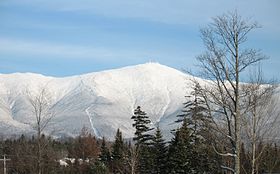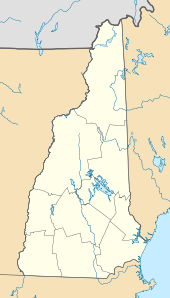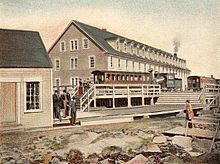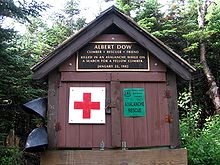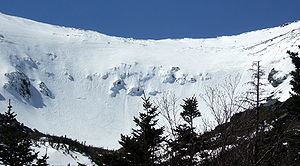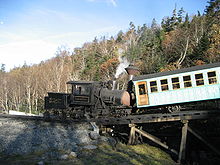- Mount Washington (New Hampshire)
-
Mount Washington
Mount Washington, from Bretton Woods.
The cog railway track is visible, on the spur to the left of the summit.Elevation 6,288 ft (1,917 m) NAVD 88[1] Prominence 6,138 ft (1,871 m) [2] Listing Ultra prominent peak;
White Mountain 4000-footers;
#1 New England Fifty Finest;
U.S. state high pointLocation Sargent's Purchase, Coos County, New Hampshire, USA Range Presidential Range Coordinates 44°16′13″N 71°18′12″W / 44.2702778°N 71.3033333°WCoordinates: 44°16′13″N 71°18′12″W / 44.2702778°N 71.3033333°W[3] Topo map USGS Mount Washington[3] Climbing First ascent 1642 Easiest route Hike, ride cog railway, or drive via Mount Washington Auto Road. Mount Washington is the highest peak in the Northeastern United States at 6,288 ft (1,917 m), famous for dangerously erratic weather. For 76 years, a weather observatory on the summit held the record for the highest wind gust directly measured at the Earth's surface, 231 mph (372 km/h) (or 103 m/s), on the afternoon of April 12, 1934.[4] It was known as Agiocochook, or "Home of the Great Spirit", before European settlers arrived.[5]
The mountain is located in the Presidential Range of the White Mountains, in the township of Sargent's Purchase, Coos County, New Hampshire. While nearly the whole mountain is in the White Mountain National Forest, an area of 59 acres (0.24 km2) surrounding and including the summit is occupied by Mount Washington State Park.
Contents
History
The first European to mention the mountain was Giovanni da Verrazzano, in 1524, from the Atlantic Ocean, as "high interior mountains". Darby Field claimed to have made the first ascent of Mt. Washington in 1642.[6] A geology party, headed by Dr. Cutler, named the mountain in 1784.[7] The Crawford Path, the oldest mountain hiking trail in the United States, was laid out in 1819 as a bridle path from Crawford Notch to the summit and has been in use ever since. Ethan Allen Crawford built a house on the summit in 1821, which lasted until a storm in 1826.[7]
Little occurred on the summit itself until the mid-19th century, when it was developed into one of the first tourist destinations in the nation, with construction of more bridle paths and two hotels. The Summit House opened in 1852, a 64-foot-long (20 m) stone hotel anchored by four heavy chains over its roof. In 1853, The Tip-Top House was erected to compete. Rebuilt of wood with 91-rooms in 1872-1873, The Summit House burned in 1908, then was replaced in granite in 1915.[7] The Tip-Top House alone survived the fire; today it is a state historic site, recently renovated for exhibits. Other Victorian era tourist attractions included a coach road (1861)—now the Mount Washington Auto Road—and the Mount Washington Cog Railway (1869), both of which are still in operation.[8]
For forty years an intermittent daily newspaper, called Among The Clouds, was published by Henry M. Burt at the summit each summer, until 1917. Copies were circulated via the Cog Railway and coaches to surrounding hotels and other outlets.
In November 2010 it was revealed that Orlando, Florida-based CNL Financial, which owns the Mount Washington Hotel at the foot of the mountain, had formally filed to trademark the "Mount Washington" name. CNL officials said they were directing their efforts against other hotels that use the mountain's name and not the numerous businesses in the area that use it.[9][10] CNL's application at the U.S. Patent and Trademark Office seeks registration of the trademark "Mount Washington" for any retail service, any restaurant service, and any entertainment service.[11]
Climate
Mount Washington Climate chart (explanation) J F M A M J J A S O N D 8.514-47.315-29.42168.429168.242308.45039854438.153428.646357.736241028148.8192Average max. and min. temperatures in °F Precipitation totals in inches Source: NOAA Metric conversion J F M A M J J A S O N D 216-10-20186-10-19239-6-15214-1-92095-1212104204126205126217811952-4266-2-10225-8-17Average max. and min. temperatures in °C Precipitation totals in mm The summit station of Mount Washington has an alpine climate (Köppen ET), though warming to a subarctic climate (Köppen Dfc) with lower elevation,[12] although it receives an extremely high amount of precipitation, atypical for most regions with such cold weather.
The weather of Mount Washington is notoriously erratic. This is partly due to the convergence of several storm tracks, mainly from the South Atlantic, Gulf region and Pacific Northwest. The vertical rise of the Presidential Range, combined with its north-south orientation, makes it a significant barrier to westerly winds. Low-pressure systems are more favorable to develop along the coastline in the winter months due to the relative temperature differences between the Northeast and the Atlantic Ocean. With these factors combined, winds exceeding hurricane force occur an average of 110 days per year. From November to April, these strong winds are likely to occur during two-thirds of the days.
Mount Washington once held the world record (still the Northern Hemisphere and Western Hemisphere record) for directly measured surface wind speed, at 231 mph (372 km/h), recorded on the afternoon of April 12, 1934. Although this record was surpassed in Cyclone Olivia in 1996, this wasn't reported as official until 2010.[13] It can still be argued that Mount Washington holds the record for the highest surface wind speed recorded 'by man'; the new Australian record was measured by an automated station while no human was present, while the Mount Washington wind gust was actually measured by a human being. Phenomena measured via satellite or radar, such as tornadoes, hurricanes, and air currents in the upper atmosphere, are not directly measured at the Earth's surface and do not compete with either of these records.
The first regular meteorological observations on Mount Washington were conducted by the U.S. Signal Service, a precursor of the National Weather Service, from 1870 to 1892. The Mount Washington station was the first of its kind in the world, setting an example followed in many other countries. For many years, the record low temperature was thought to be −47 °F (−44 °C) occurring on January 29, 1934, but upon the first in-depth examination of the data from the 19th century at NOAA's National Climatic Data Center in Asheville, North Carolina, a new record low was discovered. Mount Washington's official record low of −50 °F (−46 °C) was recorded on January 22, 1885. However, there is also hand-written evidence to suggest that an unofficial low of −59 °F (−51 °C) occurred on January 5, 1871.
On January 16, 2004, the summit weather observation registered a temperature of −43.6 °F (−42.0 °C) and sustained winds of 87.5 mph (140.8 km/h), resulting in a wind chill value of −103 °F (−75 °C) at the mountain.[14] During a 71-hour stretch from around 3 p.m. on January 13 to around 2 p.m. on January 16, 2004, the wind chill on the summit never went above −50 °F (−46 °C).[14] Snowstorms at the summit are routine in every month of the year, with snowfall averaging 311 inches (7.9 m) per year. Temperatures above 72 °F (22 °C) at the summit have never been recorded.[15]
The primary summit building was designed to withstand 300 mph (480 km/h) winds; other structures are literally chained to the mountain. In addition to a number of broadcast towers, the mountain is the site of a non-profit scientific observatory reporting the weather as well as other aspects of the subarctic climate of the mountain. The extreme environment at the top of Mount Washington makes using unmanned equipment problematic. The observatory also conducts research, primarily the testing of new weather measurement devices. The Sherman Adams summit building, which houses the observatory, is closed to the public during the winter and hikers are not allowed inside the building except for emergencies and pre-arranged guided tours.
The Mount Washington Observatory reoccupied the summit in 1932 through the enthusiasm of a group of individuals who recognized the value of a scientific facility at that demanding location. The observatory's weather data have accumulated into a valuable climate record since. Temperature and humidity readings have been collected using a sling psychrometer, a simple device containing two mercury thermometers. Where most unstaffed weather stations have undergone technology upgrades, consistent use of the sling psychrometer has helped provide scientific precision to the Mount Washington climate record.
The observatory makes prominent use of the slogan "Home of the World's Worst Weather", a claim that originated with a 1940 article by Charles Brooks (the man generally given the majority of credit for creating the Mount Washington Observatory), titled "The Worst Weather In the World" (even though the article concluded that Mt Washington most likely did not have the world's worst weather).[16][17]
Precipitation
Due to its high altitude, Mount Washington receives an extremely large quantity of precipitation, averaging an equivalent of around 102 in (2,590 mm) of rain per year, with a record high of 130.14 in (3,305.6 mm) in 1969 and low of 71.34 in (1,812.0 mm) in 1979. Large amounts of precipitation often fall in a short period of time. In October 1996, a record 11.07 in (281.2 mm) of precipitation fell during a single 24-hour period. A substantial amount of the precipitation falls as snow, with a yearly average of around 310 inches (7.9 m) of snow, and a record of 566.4 in (1,438.7 cm) during the 1968-69 snow season. The record amount of snowfall in a 24-hour period, 49.3 in (125.2 cm), occurred in February 1969.[15]
Climate data for Mount Washington (near the summit) Month Jan Feb Mar Apr May Jun Jul Aug Sep Oct Nov Dec Year Record high °F (°C) 47
(8)43
(6)54
(12)60
(16)66
(19)72
(22)71
(22)72
(22)69
(21)59
(15)52
(11)47
(8)72
(22)Average high °F (°C) 14.0
(−10)14.8
(−9.6)21.3
(−5.9)29.4
(−1.4)41.6
(5.3)50.3
(10.2)54.1
(12.3)53.0
(11.7)46.1
(7.8)36.4
(2.4)27.6
(−2.4)18.5
(−7.5)33.9 Average low °F (°C) −3.7
(−19.8)−1.7
(−18.7)5.9
(−14.5)16.4
(−8.7)29.5
(−1.4)38.5
(3.6)43.3
(6.3)42.1
(5.6)34.6
(1.4)24.0
(−4.4)13.6
(−10.2)1.7
(−16.8)20.4
(−6.44)Record low °F (°C) −50
(−45.6)−46
(−43.3)−38
(−38.9)−20
(−28.9)−2
(−18.9)8
(−13.3)24
(−4.4)20
(−6.7)9
(−12.8)−5
(−20.6)−20
(−28.9)−46
(−43.3)−50
(−45.6)Precipitation inches (mm) 8.52
(216.4)7.33
(186.2)9.42
(239.3)8.43
(214.1)8.21
(208.5)8.36
(212.3)8.02
(203.7)8.08
(205.2)8.55
(217.2)7.66
(194.6)10.49
(266.4)8.84
(224.5)101.91
(2,588.5)Snowfall inches (cm) 52.0
(132.1)44.3
(112.5)53.9
(136.9)43.9
(111.5)12.5
(31.8)1.3
(3.3)0
(0).2
(0.5)2.2
(5.6)13.7
(34.8)38.3
(97.3)48.7
(123.7)311
(790)Avg. precipitation days (≥ 0.01 in) 21.1 18.7 19.6 17.9 17.0 16.0 15.9 15.4 15.2 16.9 20.0 21.0 214.7 Avg. snowy days (≥ 0.1 in) 20.4 18.2 17.7 14.2 6.6 1.2 0 .2 2.0 9.2 15.9 19.3 124.9 Source no. 1: NOAA (normals 1971−2000)[18] Source no. 2: extremes 1933−present[15] Geographical features
Although the western slope that the Cog Railway ascends is straightforward from base to summit, the mountain's other sides are more complex. On the north side, Great Gulf—the mountain's largest glacial cirque—forms an amphitheater surrounded by the Northern Presidentials: Mounts Clay, Jefferson, Adams and Madison. These connected peaks reach well into the treeless alpine zone. Massive Chandler Ridge extends northeast from the summit of Washington to form the amphitheater's southern wall and is the incline ascended by the automobile road.
East of the summit, a plateau known as the Alpine Gardens extends south from Chandler Ridge at about 5,200 feet (1,600 m) elevation. It is notable for plant species either endemic to alpine meadows in the White Mountains or outliers of larger populations in arctic regions far to the north. Alpine Gardens drops off precipitously into two prominent glacial cirques. Craggy Huntington Ravine offers rock and ice climbing in an alpine setting. More rounded Tuckerman Ravine is New England's premier venue for spring back-country skiing as late as June and then a scenic hiking route. It rises about 500 meters above alpine tree line.
South of the summit lies a second and larger alpine plateau, Bigelow Lawn, at 5,000 feet (1,500 m) to 5,500 feet (1,700 m) elevation. Satellite summit Boott Spur and then the Montalban Ridge including Mount Isolation and Mount Davis extend south from it, while the higher Southern Presidentials—Mounts Monroe, Franklin, Eisenhower, Pierce, Jackson and Webster—extend southwest to Crawford Notch. Oakes Gulf separates the two high ridges.
Uses
The mountain is part of a popular hiking area, with the Appalachian Trail crossing the summit and one of the Appalachian Mountain Club's eight mountain huts, the Lakes of the Clouds Hut, located on one of the mountain's shoulders. Winter recreation includes Tuckerman Ravine, famous for its Memorial Day skiing and its 45-degree slopes. The ravine is notorious for its avalanches, of which about 100 are recorded every year, and which have killed six people since 1849.[19] Scores of hikers have died on the mountain in all seasons, due to harsh and rapidly changing conditions, as well as inadequate equipment, failing to plan for the wide variety of conditions which can occur above tree line, and poor decisions once the weather began to turn dangerous.[20]
The weather at Mount Washington has made it a popular site for glider flying. In 2005, it was recognized as the 14th National Landmark of Soaring.[21]
Hiking
The most popular hiking trail approach to the summit is via the 4.2-mile (6.8 km) Tuckerman Ravine Trail. It starts at the Pinkham Notch camp area and gains 4,280 feet (1,300 m), leading straight up the bowl of Tuckerman Ravine via a series of steep rock steps which afford spectacular views of the ravine and across the notch to Wildcat Mountain. Fatalities have occurred on the trail, both from ski accidents and hypothermia. Water bottles may be refilled at the base of the bowl 2.1 miles (3.4 km) up the trail at a well pump near a small hiker's store which offers snacks, toilets and shelter. At the summit is a center with a museum, gift shop, observation area, and cafeteria. Descent can be made by shuttle bus back to the Pinkham Notch camp for a fee. Other routes up the eastern slopes of the mountain include the Lion Head, Boott Spur, Huntington Ravine and Nelson Crag trails, as well as the Great Gulf Trail ascending from the northeast. Routes from the western slopes include the Ammonoosuc Ravine and Jewell trails and the Crawford Path (coincident with the Appalachian Trail from the southwest).
Cog Railway
Since 1869, the Mount Washington Cog Railway has provided tourists with a train journey to the summit of Mount Washington. It uses a Marsh rack system and was the first successful rack railway in the US.
Races
Every year in June, the mountain is host to the Mount Washington Road Race, an event which attracts hundreds of runners. In July the mountain is the site of Newton's Revenge and in August the Mount Washington Auto Road Bicycle Hillclimb, both of which are bicycle races that run the same route as the road race. The hillclimb's most notable victor to date has been former Tour de France contender Tyler Hamilton.
Another event, although not a race, is the annual MINIs On Top event. The drive to the summit began with 73 MINI Cooper and Cooper S vehicles and now exceeds 200 cars. MINIs On Top (or MOT) is held the Saturday of Father's Day weekend every June. The Mt. Washington Auto Road has also hosted the Mt. Washington Alternative Energy Days, a two-day gathering of alternative energy alternative vehicles.
On August 7, 1932, Raymond E. Welch, Sr., became the first one-legged man to climb Mount Washington. An official race was held and open only to one-legged people. Mr. Welch climbed the "Jacob's Ladder" route and descended via the carriage road. Raymond Welch had lost his leg due to a sledding injury as a seven-year-old child. At the time of his climb, Mr. Welch was the station agent for the Boston & Maine Railroad in Northumberland, New Hampshire.
In September 2010, Travis Pastrana set the record at 6 minutes 20.47 seconds, driving a Vermont Sportscar Subaru WRX STi. In June 2011, David Higgins set a new record for ascent of Mt. Washington in a car, at 6:11.54, using the same model vehicle.[22]
Transmitting stations
Edwin H. Armstrong installed an FM-broadcasting station on the top of Mount Washington in 1937. The station stopped operating in 1948, due to excessive maintenance costs. In 1954 a TV tower and transmitters were installed for WMTW, Channel 8, licensed to Poland Spring, Maine. The station continuously broadcast from the top of the mountain, including local forecasts by (now retired) WMTW transmitter engineer Marty Engstrom.[23] WMTW continually broadcast from the mountaintop until 2002.
Mount Washington continued FM broadcasting in 1958 with the construction of WMTW-FM 94.9, which became WHOM in 1976. WHOM and WMTW-TV shared a transmitter building, which also housed the generators to supply power to the mountain. On February 9, 2003, a fire[24] destroyed the transmitter building and the generators (where it started), which at the time still had WHOM's transmitters inside it. WHOM subsequently built a new transmitter building on the site of the old power building, and also constructed a new standby antenna on the Armstrong tower. (For the first time since 1948, the Armstrong tower was used for broadcasts.)
In 1987, WHOM and WMTW were joined on the peak of the mountain by WMOU-FM (renamed WZPK and now WPKQ) on a separate tower. Steve Powell, owner and president of New England Broadcasting, had the tower for WZPK (known as "The Peak") built higher than the other structures on the summit; it became the highest point east of the Mississippi and north of the Carolinas. The WPKQ transmitters are located in the back of the Yankee Building. Due to the extreme weather on Mount Washington, both WHOM and WPKQ use specially designed FM antennas which are housed in special cylindrical radomes, manufactured by Shively Labs of nearby Bridgton, Maine.
In June 2008, the possibility of television returning to Mount Washington came to light, with the filing by New Hampshire Public Television to move WLED-TV from its current location near Littleton to the old WMTW mast on top.[25][26]
Artistic tributes
Mount Washington has been the subject of several famous paintings, part of a New England school of art known as White Mountain art. Inspired by the Hudson River School of landscape painting, a number of artists during the Victorian era ventured into the White Mountains in search of natural subjects. Conway became their base, first arriving by coach and boarding at farmhouses, then in the 1870s by train to newly opened inns and hotels. They created a flood of paintings that found their way around the world, most notably to Hampton Court. The interest their works generated attracted others to visit Mount Washington and the region, initiating the tourism business that remains vital today.[27]
Musical tributes have also been made, such as Symphony no. 64, Op. 422 ("Agiochook"), composed around 1990 by the American composer Alan Hovhaness (1911–2000), dedicated to Mount Washington, which the composer climbed during his youth.
-
Ferdinand Richardt (1857)
-
John F. Kensett (1869)
-
Albert Bierstadt (1858)
See also
- List of U.S. states by elevation
- Mountain peaks of North America
- Mountain peaks of the United States
- Pinkham Notch
- The Mount Washington Hotel
- MS Mount Washington
Notes
- ^ "Mount Washington". NGS data sheet. U.S. National Geodetic Survey. http://www.ngs.noaa.gov/cgi-bin/ds_mark.prl?PidBox=PF0951. Retrieved 2009-02-23.
- ^ "America's 57 - The Ultras". Peaklist - Prominence of Mountains of the World. http://www.peaklist.org/USlists/USP5000.html. Retrieved 2008-08-30.
- ^ a b "Mount Washington". Geographic Names Information System, U.S. Geological Survey. 1980-07-27. http://geonames.usgs.gov/pls/gnispublic/f?p=gnispq:3:::NO::P3_FID:871352. Retrieved 2008-11-28.
- ^ The current record gust of 113.2 m/s was measured at Barrow Island, Australia, on October 4, 1996. [1]
- ^ "Dartmouth College Library Collections". Proquest.com. http://www.proquest.com/products_umi/descriptions/Dartmouth-College-Library-Collections-400.shtml. Retrieved 2008-03-08.
- ^ USGW Archives C. Norris & Co. , Exeter, NH, ©1817 (1817). "Gazetteer of the State of New Hampshire 1817". http://files.usgwarchives.org/nh/carroll/history/gazetteers/1817features.txt. Retrieved 2008-08-24.
- ^ a b c Condensed Facts About Mount Washington, Atkinson News Co., 1912.
- ^ Frank Hunt Burt, ''Mount Washington; A Handbook for Strangers;'' Frank H. Burt, publisher; Boston, Massachusetts 1906. Books.google.com. 2008-10-06. http://books.google.com/books?id=wxIuAAAAYAAJ&pg=PA24&lpg=PA24&dq=Summit+House+Mount+Washington+Chronology&source=bl&ots=R0taEhxADH&sig=LfDFwxTobnxybKlUBjc0orJueRw&hl=en&ei=xGUiS_PjN4OVtgejmcjjBw&sa=X&oi=book_result&ct=result&resnum=6&ved=0CBsQ6AEwBQ#v=onepage&q=&f=false. Retrieved 2010-11-13.
- ^ POSTED: 5:31 pm EST November 11, 2010. "Battle Brews Over Attempt To Trademark 'Mount Washington' - News Story - WMUR Manchester". Wmur.com. http://www.wmur.com/r/25763906/detail.html. Retrieved 2010-11-13.
- ^ POSTED: 5:30 pm EST November 12, 2010. "Hotel Owners Say Concerns Over Mount Washington Name Overblown - News Story - WMUR Manchester". Wmur.com. http://www.wmur.com/r/25776429/detail.html. Retrieved 2010-11-13.
- ^ U.S. Trademark Applications Serial Nos. 7669738, 76690735 and 76690740
- ^ "Mount Washington Observatory: Distance Learning, Retrieved Jul. 1, 2009". Mountwashington.org. http://www.mountwashington.org/education/distancelearning/. Retrieved 2010-11-13.
- ^ "Info note No.58 — World Record Wind Gust: 408 km/h". World Meteorological Association. 2010-01-22. http://www.wmo.int/pages/mediacentre/infonotes/info_58_en.html.
- ^ a b "History for Mt. Washington, NH". Weather Underground. http://www.wunderground.com/history/airport/KMWN/2004/1/16/DailyHistory.html?req_city=NA&req_state=NA&req_statename=NA. Retrieved 2008-03-08.
- ^ a b c "Mount Washington Observatory: Normals, Means and Extremes". Mount Washington Observatory. http://www.mountwashington.org/weather/normals.php. Retrieved 2010-08-07.
- ^ "Allen Press "The Mount Washington Weather Observatory - 50 Years Old"". Ams.allenpress.com. 1970-01-01. http://ams.allenpress.com/perlserv/?request=get-document&doi=10.1175%2F1520-0477(1982)063%3C0986%3ATMWOYO%3E2.0.CO%3B2. Retrieved 2010-11-13.
- ^ "The Worst Weather In the World". Davidalbeck.com. http://www.davidalbeck.com/hiking/worstweather.html. Retrieved 2010-11-13.
- ^ "NCDC: U.S. Climate Normals" (PDF). National Oceanic and Atmospheric Administration. http://cdo.ncdc.noaa.gov/climatenormals/clim20/nh/275639.pdf. Retrieved 2010-03-31.
- ^ MountWashington.com - Deaths[dead link]
- ^ ibid.
- ^ "Mount Washington National Landmark of Soaring". Mount Washington Soaring Association, chapter of Soaring Society of America. http://www.ssaregion1.org/MWSA/history.htm. Retrieved 2008-10-08.
- ^ www.climbtotheclouds.com/general-info/results/
- ^ Marty Engstrom. Marty on the Mountain: 38 Years on Mt. Washington. http://www.mountwashington.org/store/index.php?main_page=product_info&products_id=36. Retrieved 2008-10-13.
- ^ "WMTW: fire on the mountain". GGN Information Systems. http://www.ggninfo.com/wmtw5.htm. Retrieved 2008-10-13.
- ^ "Application for Construction Permit for Reserved Channel Noncommercial Educational Broadcast Station". U.S. Federal Communications Commission (FCC). June 20, 2008. http://fjallfoss.fcc.gov/cgi-bin/ws.exe/prod/cdbs/forms/prod/cdbsmenu.hts?context=25&appn=101249595&formid=340&fac_num=69328. Retrieved 2008-10-13.
- ^ "Mount Washington, N.H.: A Look Back". fybush.com. 2003-02-20. http://www.fybush.com/site-030220.html. Retrieved 2008-03-08.
- ^ "White Mountain Art & Artists". Whitemountainart.com. 2010-08-25. http://whitemountainart.com/OnePageImages/washington_jfk_001.htm. Retrieved 2010-11-13.
External links
- Mount Washington Observatory
- Mount Washington Cog Railway
- Mount Washington Auto Road
- 19th-century paintings of Mount Washington
- Mount Washington weather facts
- Computer generated summit panoramas North South West to Adirondack Group Index
- National Geographic: Mount Washington - Backyard Arctic
- PeakBagger.com entry
U.S. State Highest Natural Points Alabama • Alaska • Arizona • Arkansas • California • Colorado • Connecticut • Delaware • Florida • Georgia • Hawaii • Idaho • Illinois • Indiana • Iowa • Kansas • Kentucky • Louisiana • Maine • Maryland • Massachusetts • Michigan • Minnesota • Mississippi • Missouri • Montana • Nebraska • Nevada • New Hampshire • New Jersey • New Mexico • New York • North Carolina • North Dakota • Ohio • Oklahoma • Oregon • Pennsylvania • Rhode Island • South Carolina • South Dakota • Tennessee • Texas • Utah • Vermont • Virginia • Washington • West Virginia • Wisconsin • Wyoming
4000-foot mountains of New England Baxter State Park High Peaks Abraham · Crocker · Redington · Saddleback · Saddleback, The Horn · South Crocker · Spaulding · SugarloafBigelow Range Eastern White Mountains Northern ranges Carter-Moriah Range Presidential Range Crawford Notch area Twin Range Pemigewasset Wilderness Sandwich Range Osceola · Osceola (East) · Tripyramid (Middle) · Tripyramid (North) · Passaconaway · Tecumseh · WhitefaceFranconia Range Western White Mountains Green Mountains Categories:- Mount Washington (New Hampshire)
- Mountains of New Hampshire
- New England Four-thousand footers
- Climbs in cycle racing
- Mountains on the Appalachian Trail
- Landforms of Coos County, New Hampshire
- Visitor attractions in Coos County, New Hampshire
- Highest points of U.S. states
-
Wikimedia Foundation. 2010.

